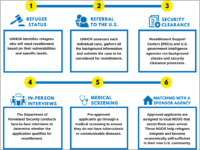In mid-October 2021, President Joe Biden announced that the United States would be allowing up to 125,000 refugees into the country for this financial year. However, it is unsure whether or not the United States will be able to meet its goal due to the backlog from various events, including COVID-19 and, more significantly, the previous Trump administration. As a result, the month (October) began with the release of the most recent refugee admittance and resettlement figures, which were not even close to the ceiling Biden announced last year.
Presidential Determination during past Administrations
The number of refugees that have been allowed to enter the United States has significantly decreased ever since Trump came to power. This number has traditionally been set through a refugee resettlement ceiling officially known as the Presidential Determination (LIRS 2020). The ceiling is a figure that the government of the day sets by consulting and reaching an agreement with the House and Senate of Judiciary Committees to explain how many refugees they plan to admit and the impact this will have on their economy and foreign policy (LIRS 2020). However, there is no formal obligation to meet this goal. So whilst on paper, they have written how many they plan to admit, in practice, they can stop admitting refugees once they have met this Presidential Determination (LIRS 2020).
The number of refugees admitted and resettled under the Obama Administration has remained rather high. In particular, since 1980, the Presidential Determination has tended to be around 95,000 persons (LIRS 2020). Although due to 9/11, 2002 had the lowest Presidential Determination of 70,000, with only 27,131 refugees being admitted (Migration Policy Index n.d.). The highest Presidential Determination was set to 110,000 refugees by Obama in 2016 (LIRS 2020). However, this figure was significantly reduced to 50,000 as soon as the term of the Trump Administration began (LIRS 2020). Unfortunately, these figures continued to decrease during the four years that Trump remained in power. The ceiling dropped to 45,000 in 2018, 30,000 in 2019, and 18,000 in 2020 (Migration Policy Index n.d.). The 2020 ceiling was the lowest that it had ever been, which was heightened by the restrictions posed as a result of the COVID-19 Pandemic. This is because the Pandemic “restricted travel, as well as the ability to safely interview resettlement applicants” (Abdalla, 2021).
Since Biden’s Presidential Term began, he has slowly been increasing the ceiling. In 2021, the figure increased to 62,500, and for this year (2022), it has increased to 125,000 (Migration Policy Index n.d.). This is a highly significant figure as it is 15,000 more than what Obama had set in 2016. It is also important to look at the ceiling with regard to the number of refugees that were actually admitted and resettled by the Biden Administration. Despite 62,500 refugees being set in 2021, only 11,411 refugees were admitted and resettled, which is a mere 18% (Migration Policy Index n.d.). In addition, only 25,465 have been admitted and resettled this year, which accounts for 20% of their set goal (Montoya-Galvez 2022). This reflects how despite the Presidential Determination being set very high, only a mere percentage of refugees are actually being admitted and resettled in the United States.
Resettlement Process in the United States
The process of resettlement in the United States takes approximately 2 years; however, in reality, it often takes many more years. The United Nations High Commissioner for Refugees (UNHCR) has provided a brief summary of the process, which I have attached below. In addition, the top ten states for refugee resettlement in the United States are California, Texas, New York, Michigan, Washington, Kentucky, North Carolina, Pennsylvania, Arizona, and Ohio (UNHCR 2022).
With the announcement of this year’s admitted and resettled refugees, the case of Chantal Nabageni was brought to light. Chantal is a Congolese refugee living in East Moline, Illinois, who has been waiting for her husband to join her and her daughter for the past four years (Montoya-Galvez, 2022). Before arriving in the United States, Chantal and her family were resettled refugees in Burundi for 13 years(Montoya-Galvez, 2022). During this time, she met and married her husband (Montoya-Galvez, 2022). In 2018, the family’s resettlement journey to the United States began; however, her husband was unable to join them as Chantal applied for refugee resettlement before she was married (Montoya-Galvez 2022). After arriving in the United States, in 2019, Chantel applied for her husband to join them as he was married to a refugee, yet he has still been unable to enter the United States (Montoya-Galvez 2022). Chantal also gave birth following her arrival in the United States without her husband by her side (Montoya-Galvez, 2022). In addition, the restrictions of the Pandemic did not help her case as it just made her long for her husband more (Montoya-Galvez 2022). However, in 2021, Chantal and her daughter were able to travel to Burundi to reunite with her husband (Montoya-Galvez 2022). This reflects how despite the Biden Administration wanting to increase the numbers of refugees, not much is being done on the resettlement and processing front to actually get them to the United States.
Chantal claims that it is stressful to provide for her daughter and family as she is studying and working full-time, in addition to constantly worrying about her husband (Montoya-Galvez 2022). However, in the past year, Citizenship and Immigration Service officials have been working on processing pending refugee cases that have been held up due to Trump’s Administration and the backlog of COVID-19 (Montoya-Galvez 2022). This is reflected by 44,000 refugee applicants being interviewed in 2022 as opposed to the 9,100 interviewed in 2021 (Montoya-Galvez 2022). The refugee resettlement process typically involves 6 steps, but most of them tend to take more time. In particular, security and medical checks take a lot more time as they rely on others to take them.
The Future of Refugee Resettlement in the United States
The case of Chantal thus reflects the flaws in the United States’ Refugee Resettlement Process. The Biden Administration claims to resettle many refugees, but the figures reflect the opposite, as only a mere percentage of their ceiling are actually being admitted and resettled in the United States. In effect, it will be interesting to see what measures the United States will take so they can meet their goal. In addition, it will also be interesting to see how the Russian Invasion of Ukraine will impact this. Thus, Chantal’s case reflects how families get separated when they are seeking refuge. In effect, future refugee resettlement should emphasise family reunifications so families can safely and happily start a new life together.
References
Abdalla, Jihan. 2021. “US eyes ‘aspirational’ refugee resettlement goal.” Last accessed 29 October 2022, from https://www.aljazeera.com/news/2021/10/14/us-eyes-aspirational-refugee-resettlement-goal.
LIRS. 2020. “Frequently Asked Questions: Refugee Ceiling and the Presidential Determination.” Last accessed 29 October 2022, from https://www.lirs.org/faqs-refugee-ceiling/.
Migration Policy Index. n.d. “U.S. Annual Refugee Resettlement Ceilings and Number of Refugees Admitted, 1980-Present.” Last accessed 29 October 2022, from https://www.migrationpolicy.org/programs/data-hub/charts/us-refugee-resettlement.
Montoya-Galvez, Camilo. 2022. “Biden administration falls 80% short of 2022 refugee admissions target.” Last accessed 29 October 2022, from https://www.cbsnews.com/news/refugee-admissions-target-2022-biden-administration/.
UNHCR. 2022. “The U.S. Refugee Resettlement Program Explained.” Last accessed 29 October 2022, from https://www.unrefugees.org/news/the-u-s-refugee-resettlement-program-explained/#:~:text=It%20is%20a%20solution%20that,citizens%20of%20the%20resettlement%20country.

Himani Chauhan is an International Relations & History graduate and is currently pursuing a Master of Migration Studies from Victoria University of Wellington (New Zealand). She comes from a family of immigrants, which has shaped her experiences, views, and interests in wanting to further explore and work in this area of study. Her area of interest includes – Migration, History, and Human Rights.

